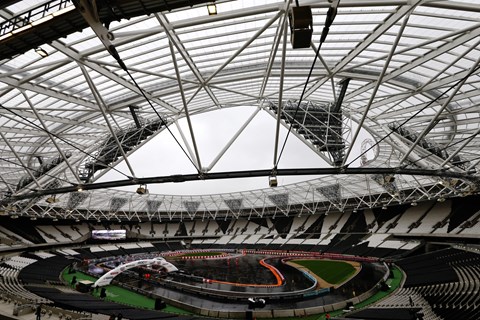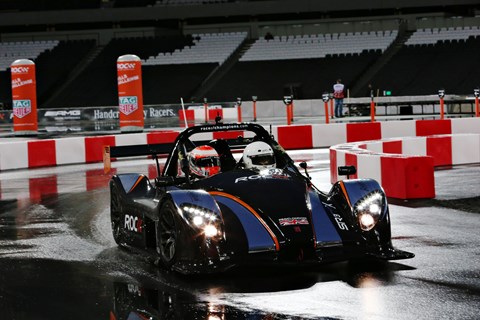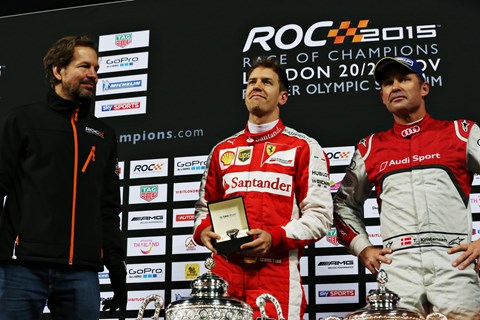► A passenger ride with a difference
► Semi-finals at the Race of Champions
► Alex Buncombe vs Tom Kristensen
I can’t feel my feet. Partly because it’s a freezing November evening, and partly because my calves are balanced on a fire extinguisher, gradually cutting off their blood supply. I can’t move my head much either, a HANS device keeping it screwed on tight. I’m harnessed into the passenger side of a Radical SR3 RSX’s laydown bathtub seat moulding, in a holding area somewhere in the bowels of London’s Olympic stadium. Just in front of me, F1 heroes Sebastian Vettel and David Coulthard are climbing into a pair of KTM X-Bows. Surreal doesn’t quite cover it.
It’s the semi-finals of the 2015 Race of Champions, the annual stadium-based knockout tournament where the world’s best drivers battle it out in an eclectic mix of cars, from NASCAR stockers to Ariel Atoms, via AMG Mercs and off-road buggies. Only a few weeks ago the Queen Elizabeth Park stadium hosted the Rugby World Cup; now it’s turf has temporarily been replaced with tarmac, transforming the pitch into a twisting miniature race circuit. It’s like God’s own Scalextric set.

Since the majority of cars in the competition are two-seaters, that means there’s space for passengers to sit alongside the drivers as they vie for glory. And thanks to some unexpected string-pulling by event sponsors TAG Heuer, for the second semi-final heat I’m one of them. The fast pace of the event means I’ve no idea who my driver’s going to be – the drivers themselves don’t find out which car they’ll be in until a matter of minutes before they race. As Vettel and DC exit the holding area in a blaze of wheelspin, the Radical crew descend on the car with stickers reading ‘A. Buncombe’ and a Nismo-branded, fireproof-suited leg lands on the driver’s seat next to me. My driver’s going to Alex Buncombe, the rapid factory Nissan Le Mans and GT racer known for his take-no-prisoners overtaking skills. Take a look at this video for a case study…
Next to us, in an identical SR3 RSX, is a man known for being quite quick in sports racing cars: nine-time Le Mans winner Tom Kristensen. This should be interesting. Time to go; Kristensen lights up his rear tyres, trying to get some semblance of heat into them, and Alex does the same. The SR3’s rev-happy 1500cc engine’s shriek bounces around the undersides of the grandstands, and my eardrums feel like they’re doing something similar. We emerge into the light and noise of the stadium’s centre, and Alex positions the car right up against the barrier, giving him the best approach possible to the outside track’s fast first corner. Kristensen’s directly adjacent to us, facing the other way – this will be a track cycling-style pursuit against the clock.

Revs up, clutch up and we’re away, flat-out through the first curve and pivoting on the brakes into a long, ever-tightening left-hander, Buncombe’s hands constantly adjusting and readjusting steering angle, panning for grip as he feels his way into the car and the track. Later he’ll tell me this was the first time he’s driven the Radical in the dry – the briefest-of-brief practice runs the drivers got in each car prior to the event took place in pouring rain. Now the track’s coated in winter Teflon that’s not quite full dry, not quite full wet, but definitely slippery.
The SR3 doesn’t have the widest of cockpits, so I spend most of the race concentrating on keeping my elbow tucked inside the seat so as not to elbow Al in the ribs, as if I’m telling him a nudge-nudge-wink-wink joke mid-race. All too soon the chequered flag’s out, the startline pyrotechnics fire and we’re across the line, five crucial tenths after Kristensen.
It’s a best of three, however, so no sooner have we crossed the line than Alex begins working the brakes and tyres for round two. This time we’re starting from the inside lane and get a cleaner start. ‘The Race of Champions is all about being able to instantly adapt to the next car you get in,’ Alex tells me later. ‘You get next to no practice, just straight out onto the grid, so you’re learning all the time. The second lap of each race for most drivers is almost two seconds quicker than their first, because you know a little bit more [about the car and the track conditions]. And the Radical’s way, way quicker than the other cars…’ Bearing his theory out, Alex seems even faster, more fluid, more keyed into the car in round two. He’s surgically precise through the fiddly chicane sections, and when he attacks the fastest corner on the circuit, he shaves the barrier so close it feels almost as if I could tilt my head into it.

We cross the line in what feels like a dead heat with Kristensen, and with the finish stripe out of sight from my low vantage point I can’t tell who’s won until I see Kristensen and his passenger punching the air on one of the big screens. Al shrugs philosophically as we trundle back to the holding area. ‘It had to happen at some point I guess,’ he tells me later. Through to the final four drivers in his first ROC can’t be a bad feeling, surely? ‘It’s just been a pleasure to be involved with the whole event. Hopefully I get invited again next year…’ Is it weird racing with a passenger? ‘Not really, I forgot you were there!’
Kristensen’s 0.26sec win means he’s through to his fourth ROC final, against Vettel. And he’s still yet to win one – it’s Sebastian who takes the champion’s Henri Toivonen Memorial Trophy, and a nice watch for his troubles. Looking at the relaxed smiles on the drivers’ faces in parc ferme, though, freed from the pressure cooker of professional racing for a weekend, it seems like this is one event where it really is the taking part that counts.